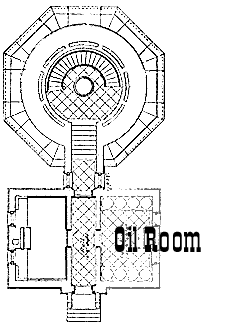Oil Room

This is where we stored the fuel used to light the lamp in the lens when the light-house first went into operation. We used lard-oil to light the 4-wick lamp used in the first-order lens. It was shipped down here from the San Francisco district office. We would very carefully pour out just enough for the night, taking precautions to be sure we didn't waste any oil. It took about two gallons plus one pint for 10 hours of service. Then we would carry the oil for the night up the stairs to the lantern room. Every night, up all those stairs. Not that we minded, much.
The Light House Board switched to lard oil from sperm-oil. Sperm oil was rendered from sperm whales and had been use to light the lamps in United States light-houses since 1812. Sperm-oil worked fine but each year there were fewer and fewer sperm whales. The oil from the ones that were caught was also being used for other purposes, such as a lubricant. All this drove the price per gallon for sperm-oil up to $2.43 1/2. At one time the price had been as low as $1.09 per gallon. By comparison, the highest the Light-house Board ever paid for lard-oil was $2.27. At one time it had been as low as 48 1/2 cents per gallon.
A First-order lamp, like the one used at Pigeon Point, was allotted 760 gallons of lard-oil per year. By 1872, the year the Pigeon Point Light-house went into service, the Light House Board was spending $85,355.00 a year on lard-oil for all the U.S. Light-houses.
In 1888 we changed from lard oil to kerosene and had to install a new lamp in the lens to burn the new fuel. It was called a "Funk's Mineral Oil Lamp" and it had five concentric wicks. Folks figured out that kerosene was a bit more touchy than lard-oil so in the early 1900's they built a separate fuel house, or "bunker" out there near the flag pole. Guess they didn't want to take any chances on blowing up the light-house!
While I'm on the subject of what we call the "illuminants," I might as well finish the story of how we've kept the lens lit over the years. In about 1911 another type of lamp was installed. Instead of using burning wicks to produce the light, it forced the kerosene under pressure into a vapor chamber where it was converted to a gas. I won't bother you with all the details, but basically it worked like the lanterns used by folks for camping today. This lamp was a big improvement over the open burner type lamps used earlier and with it our lens was rated at 160,000 candlepower. It could be seen up to eighteen miles away!
Nowadays the Coast Guard has all sorts of electronic stuff in here to help ships navigate. I don't know how it works, but it seems to do the job.
